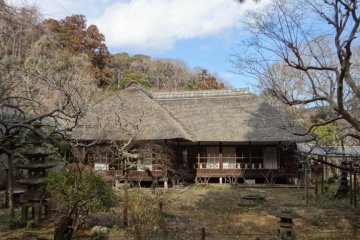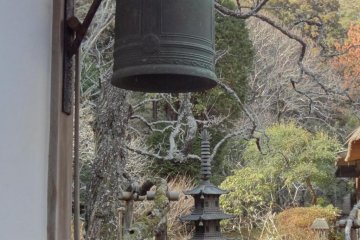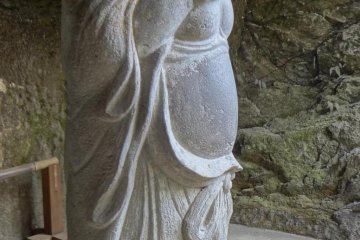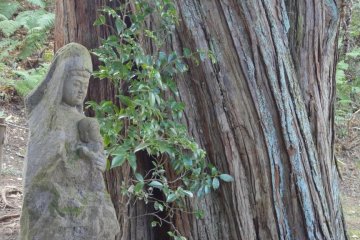Located deep in the forest in Kita-kamakura, Jochi-ji used to be huge, but is not a big temple anymore. Compared with other temples in Kita-kamakura, it isn’t very busy throughout the year. But here is the best place for you to feel the true atmosphere of Zen simplicity. Go and take a deep breath at Jochi-ji. You might acquire Zen enlightenment, not by words, but just by the feeling you catch there.
This temple opens Zen wisdom to us in many ways: through Key Words, Statues, a Garden, Cemetery, and Nature. All of these are teaching us and leading us to Buddhist enlightenment. Coming to this temple is almost equal to hunting for the treasures of life!
For example, 寳所在近 (Ho-sho-zai-kin) is the word displayed on the main gate of Jochi-ji temple. It implies “The treasure you are searching for is already in your pocket.”
In a cave on the temple grounds, you will meet a potbellied stone man pointing at you with a bright smile. You might rub his belly without thinking. But there is a hidden meaning here. In front of this statue, you will see a Japanese explanation that says by touching his belly you will obtain energy. And again, there is the suggestion that “The treasure you are searching for is already in your pocket.” Moreover, 寳所在近 is a caution for the priests practicing here: “Practice hard wherever you are.”
Now, let’s take a look around this simple but beautiful Zen temple.
Bell-building gate
In this first building, a bell (built in 1340) hangs from a second floor alcove above the first floor gate. Consequently, you walk under the bell. You might see writing displayed under the eves. It says 山居幽勝 (san-kyo-yu-sho) and means “here is a hermitage in a deep calm forest.” The gate is a boundary for a sacred place where they are concentrating with stiff resolution on Zen practices apart from the outside world.
The main hall
When you go straight under and through the bell-building, you will see a small hall on the right. There are three principle images at the center of the hall. From the left: Amitabha, Buddha, and Maitreya. Each of them implies respectively: the past, present and future. In Buddhism, time is insubstantial, but the moment you are in now is quite important; the results of the past are related to the present, and the results of the present will be shown in the future. These three statues symbolize this logic.
Gigantic podocarpus
You will see some gigantic trees in Jochi-ji. One of them is a podocarpus (evergreen conifer) near the main hall. There is a small stone statue holding a baby near the root of the tree. It is called Koyasu-kannon, the Goodness of Mercy for a Child. It reminds me of the Blessed Virgin Mary. I wonder if it might have been set up for secret believers in Christianity in the old days.
Garden & Hojo (The residence of the Head Priest)
Next, we can see inside the Hojo from outside. It has a thatched roof with a narrow, glassed-in wooden corridor inside the house facing the garden. A pagoda-like stone lantern as well as a tall metal lantern—with Hojo in the background—creates a beautiful, traditional Japanese scene. Many kinds of trees and flowers grow in the garden, and you will enjoy the colorful combination of the plants especially in spring and summer. But even in winter, although almost nothing is blooming, you can appreciate the interesting curves of the branches, thick contrast of the light and shadow, and cold but clear air filling this space. This is Zen at its finest.
Gravestones
If you make your way to the innermost part of the premises, you will find a cemetery area. You might be seeing Japanese graves for the first time. Quietly passing through it and going along the walkway, you will reach a cliff side, where a lot of gravestones are collected. This is the location of an ancient cemetery.
Hotei Statue
Walk through a small bamboo grove and pass through a small tunnel. Soon you will come to a stone statue in a cave. This is Hotei from the seven Gods of Good Fortune. This statue isn’t holding a bag, but a typical Hotei usually holds a big bag on his shoulder. That bag is his symbol. We usually call a cloth bag a ‘hotei’, so people started to call him Hotei. The model of the statue is the Chinese priest, Kaishi. He was born in 10th century China and walked around predicting the weather and people’s futures. Because of this, Hotei is usually thought to be the incarnation of Maitreya, who will help us 57600 million years later!
















